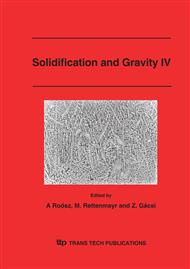[1]
A. Chatterjee, S. Chattopadhyay, R. Dutta, and P.K. Mukhopadhyay: Heat transfer during solidification of continuously cast slabs - mathematical modelling work at Tata Steel. In Proc. 10th Process Technology Conference- Second Internal Symposium on Modeling in the Iron and Steel Industry, Toronto, Ontario, Canada, 1992, April 5-8, pp.325-331.
Google Scholar
[2]
K. Thompson and M. Wolf: The Concast heat transfer model. A proven tool for optimized slab caster design and operation. Concast Technol. News. Vol. 27 (1988), p.6.
Google Scholar
[3]
M. Bamberger and B. Prinz: Mathematical modeling of the temperature field in continuous casting. Z. Metall. Vol. 77 (1986), No. 4, pp.234-38.
Google Scholar
[4]
P.J. Flint: A three-dimensional finite difference model of heat transfer, fluid flow and solidification in the continuous slab caster. In. Proc. of 9th Process Technology, 73rd Steelmaking Conf., Detroit, MI, (1990).
Google Scholar
[5]
M.R. Aboutalebi, M. Hasan, R.I.L. Guthrie: Thermal modelling and stress analysis in the continuous casting of arbitrary sections. Steel Research. Vol. 65 (1994), No. 6, pp.225-33.
DOI: 10.1002/srin.199401062
Google Scholar
[6]
C.R. Swaminathan and V.R. Voller: A general enthalpy method for modeling solidification processes. Metall. Trans B. Vol. 23B (1992), October, pp.651-64.
Google Scholar
[7]
G. Funk, J. Böhmer, F. Fett and R. Hentrich: Coupled thermal and stress-strain models for the continuous casting of steels. Steel Research. Vol. 64 (1993), No. 5, pp.246-54.
DOI: 10.1002/srin.199301017
Google Scholar
[8]
S.K. Choudhary, D. Mazumdar and A. Ghosh: Mathematical modelling of heat transfer phenomena in continuous casting of steel. ISIJ Int. Vol. 33 (1993), No. 7, pp.764-74.
DOI: 10.2355/isijinternational.33.764
Google Scholar
[9]
S. Barozzi, P. Fontana and P. Pragliola: Computer control and optimization of secondary cooling during continuous casting. Iron and Steel Engineer. Vol. 63 (1986), November, pp.21-26.
Google Scholar
[10]
K. -H. Spitzer, K. Harste, B. Weber, P. Monheim and K. Schwerdtfeger: Mathematical model for thermal tracking and on-line control in continuous casting. ISIJ International. Vol. 32 (1992), No. 7, pp.848-56.
DOI: 10.2355/isijinternational.32.848
Google Scholar
[11]
S. Louhenkilpi: Simulation and Control of Heat Transfer in Continuous Casting of Steel, Doctoral Thesis, Helsinki University of Technology, Finland, (1995).
Google Scholar
[12]
H. Kytönen, M. Tolvanen, S. Louhenkilpi, L. Holappa: Experimental and numerical determination of crater end in continuous casting of steel, Modelling of Welding, Casting and Advanced Solidification Processes VIII, San Diego, June 7-12, 1998, pp.631-638.
Google Scholar
[13]
J. Miettinen, H. Kytönen, S. Louhenkilpi, L. Holappa: IDS, TEMPSIMU, CASIM - Three Windows Applications for Continuous Casting of Steels, 12th IAS Steelmaking Seminar, Novenber 2-5, 1999, Buenos Aires.
Google Scholar
[14]
S. Louhenkilpi, E. Laitinen, R. Nieminen: Real-Time Simulation of Heat Transfer in Continuous Casting. Met. Trans. B. Vol. 24B (1993), August, pp.685-693.
DOI: 10.1007/bf02673184
Google Scholar
[15]
S. Louhenkilpi: Study of Heat Transfer in a Continuous Billet Casting Machine. Scand. J. Metallurgy. Vol. 23 (1994), pp.9-17.
Google Scholar
[16]
S. Louhenkilpi, R. Nieminen, M. Rekkilä: TEMPSIMU- Heat transfer model for continuous casting, User manual, Windows version 1. 5, Laboratory of Metallurgy, Helsinki University of Technology and Department of Mathematics, Jyväskylä University (1997).
Google Scholar
[17]
A. Kotipelto, Numerical and Experimental Analysis of Heat Transfer in the Continuous Casting Process of Copper, Doctoral Thesis, Tampere University of Technology, Finland, (2002).
Google Scholar
[18]
J. Miettinen, Simulation of solidification and calculation of thermophysical properties in binary fcc copper alloys - revised version, (Report TKK-MK-118, Helsinki University of Technology Publications in Materials Science and Metallurgy 2001).
DOI: 10.1016/s0927-0256(01)00239-7
Google Scholar
[19]
Ganesan, S., Poirier, D.R., Metallurgical and Materials Transactions B, vol. 21B (1990), pp.173-181.
Google Scholar
[20]
Bernard, D., Salvo, L., Nielsen Ø., Modelling of Casting, Welding and Advanced Solidification Processes X , TMS, USA, 2003, pp.175-182.
Google Scholar


